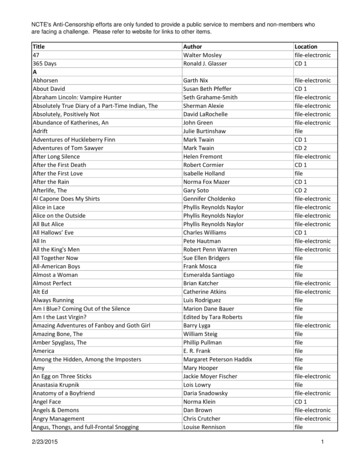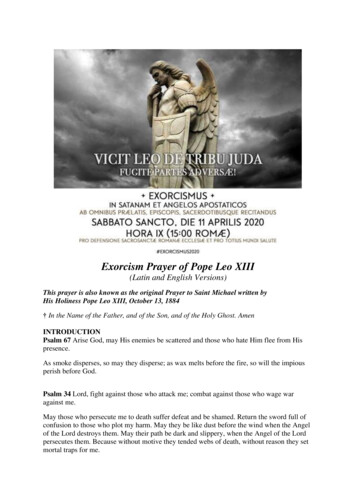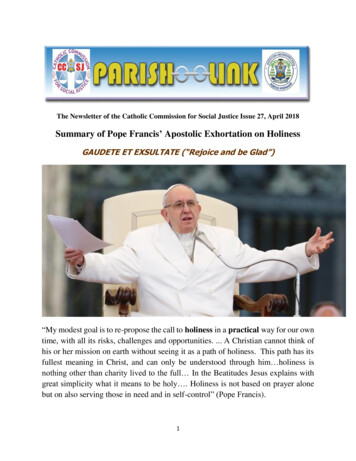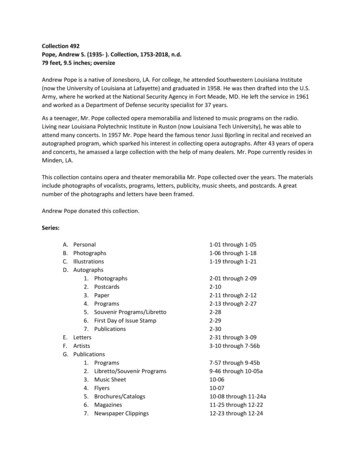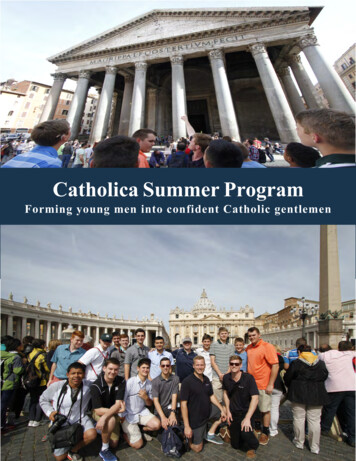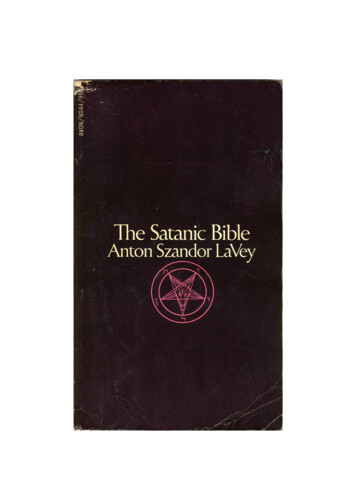
Transcription
Called “The Black Pope” by many of his followers, Anton LaVey began the road to HighPriesthood of the Church of Satan when he was only 16 years old and an organ player in a carnival:“On Saturday night I would see men lusting after half-naked girls dancing at the carnival, andon Sunday morning when I was playing the organ for tent-show evangelists at the other end of thecarnival lot, I would see these same men sitting in the pews with their wives and children, askingGod to forgive them and purge them of carnal desires. And the next Saturday night they’d be backat the carnival or some other place of indulgence.“I knew then that the Christian Church thrives on hypocrisy, and that man’s carnal nature willout!”From that time early in his life his path was clear. Finally, on the last night of April, 1966–Walpurgisnacht, the most important festival of the believers in witchcraft–LaVey shaved his headin the tradition of ancient executioners and announced the formation of The Church Of Satan. Hehad seen the need for a church that would recapture man’s body and his carnal desires as objects ofcelebration. “Since worship of fleshly things produces pleasure,” he said, “there would then be atemple of glorious indulgence. . .”
The Satanic BibleAnton Szandor LaVey
For Diane
To:Bernadino Logara, who knew the value of moneyKarl Haushofer, a teacher without a classroomRasputin, who knew the magic of a childSir Basil Zaharoff, a gentlemanCagliostro, a rogueBarnabas Saul, the link with Mount LaleshRagnar Redbeard, whose might is rightWilliam Mortensen, who looked . . . and sawHans Brick, who knows the lawMax Reinhardt, a builder of dreamsOrrin Klapp, the walking manFritz Lang, who made moving blueprintsFriedrich Nietzsche, a realistWilliam Claude Dukinfield, who saved me a journey to TibetPhineas Taylor Barnum, another great guruHans Pöelzig, who knew all the anglesReginald Marsh, a great artistWilhelm Reich, who knew more than cabinet-makingMark Twain, a very brave manAnd to:Howard Hughes, James Moody, Marcello Truzzi, Adrian-Claude Frazier, MarilynMonroe, Wesley Mather, William Lindsay Gresham, Hugo Zacchini, Jayne Mansfield,Frederick Goerner, C.Huntley, Nathaniel West, Horatio Alger, Robert Ervin Howard,George Orwell, Howard Phillips Lovecraft, Tuesday Weld, H.G. Wells, Sister MarieKoven, Harry Houdini, Togare, and the Nine Unknown Men.
INTRODUCTION I (1969-1972) by Burton H. WolfeINTRODUCTION II (1972-1976) by Michael A. AquinoINTRODUCTION III (1976-2005) by Burton H. WolfeINTRODUCTION IV (2005-) by Peter H. GilmorePREFACEPROLOGUETHE NINE SATANIC STATEMENTS(FIRE)–BOOK OF SATAN–The Infernal Diatribe(AIR)–BOOK OF LUCIFER–The EnlightenmentI Wanted!: God - Dead or AliveII The God You SAVE May Be YourselfIII Some Evidence of a New Satanic AgeIV Hell, the Devil, and How to Sell Your SoulV Love and HateVI Satanic SexVII Not all Vampires Suck BloodVIII Indulgence. NOT CompulsionIX On the Choice of a Human SacrificeX Life After Death Through Fulfillment of the EgoXI Religious HolidaysXII The Black Mass
(EARTH)–BOOK OF BELIAL–The Mastery of the EarthI Theory and Practice of Satanic Magic: (Definition and Purpose of Lesser andGreater Magic)II The Three Types of Satanic RitualIII The Ritual, or “Intellectual Decompression,” ChamberIV The Ingredients Used in the Performance of Satanic Magic:A. DesireB. TimingC. ImageryD. DirectionE. The Balance FactorV The Satanic Ritual:A. Some Notes Which are to be Observed Before Beginning RitualB. The Thirteen StepsC. Devices Used in Satanic Ritual(WATER)–BOOK OF LEVIATHAN–The Raging SeaI Invocation to SatanII The Infernal NamesIII Invocation Employed Towards the Conjuration of LustIV Invocation Employed Towards the Conjuration of DestructionV Invocation Employed Towards the Conjuration of CompassionVI The Enochian Keys and The Enochian Language (The nineteen Keys will belisted here in chronological order)Underground Edition Extras
The Satanic Bible
INTRODUCTION by Burton H. WolfeThis is the original introduction, used in the 1969 first edition through 1972INTRODUCTIONby Burton H. Wolfe*In the summer of 1966, a few newspapers in the San Francisco Bay Area began to take notice ofa body of Devil-worshippers headed by a former circus and carnival lion handler and organist,Anton Szandor LaVey. Their practice of the black arts was nothing new in the world. It had tracesin voodoo cults, a Hell-Fire Club that existed in 18th-Century England, a Satanic circle led byAleister Crowley in England a century later, and the Black Order of Germany in the 1920’s and1930’s. But two aspects of the San Francisco group made them different from their predecessors:they were blasphemously organized into a church, the First Church of Satan, instead of the usualcoven Satanism and witchcraft lore; and they carried on their black magic openly instead ofunderground.Wedding, baptism, and funeral ceremonies dedicated to the Devil were held in the Church ofSatan, with the press invited. Rituals in the tradition of the black arts were staged at midnight in theold dark Victorian house of LaVey, an incongruous building among all the white and yellow stuccohouses in the San Francisco neighborhood a short way from the cliffs along the Golden Gate.Occasionally the roar of a full-grown lion that lived in the black house with the LaVey family(Anton, 39; wife Diane, 26; and daughters Karla, 17, and Zeena, 6) reverberated through the night,spooking the neighbors, who were already upset about living so close to Hell.Somehow it was all terribly provocative. Besides, the Devil has always made “good copy,” asthey say on the city desk. By 1967, the newspapers that were sending reporters to write about theChurch of Satan extended from San Francisco across the Pacific to Tokyo and across the Atlantic toParis. When a wedding or funeral was held, with a naked woman serving as altar to Satan, theAssociated Press and other wire Services were on hand to transmit the story and the scandalousphotographs to thousands of periodicals. Groups affiliated with the Church of Satan were organizedin other parts of America and in England, France, Germany, Africa, and Australia. In existence lessthan a year, the Church of Satan had already proved one of its cardinal messages: the Devil is alivehighly popular with a great many people.Anton LaVey, called “The Black Pope” by some of his followers, realized that two decades agowhen he was playing organ for carnival sideshows. “On Saturday night,” he recalls, “I would seemen lusting after half-naked girls dancing at the carnival, and on Sunday morning when I wasplaying the organ for tent-show evangelists at the other end of the carnival lot, I would see thesesame men sitting in the pews with their wives and children, asking God to forgive them and purgethem of carnal desires. And the next Saturday night they’d be back at the carnival or some otherplace of indulgence. I knew then that the Christian church thrives on hypocrisy, and that man’scarnal nature will out no matter how much it is purged or scourged by any white light religion.”Although LaVey did not realize it then—he was only eighteen—he was on his way towardformulating a religion that would serve as the antithesis to Christianity and its Judaic heritage. Itwas an old religion, older than Christianity or Judaism. But it had never been formalized, arrangedinto a body of thought and ritual. That was to be LaVey’s role in 20th-Century civilization.All of LaVey’s background seemed to prepare him for that role. He is the descendant ofGeorgian, Roumanian, and Alsatian grandparents, including a gypsy grandma who passed on tohim the legends of vampires and witches in her native Transylvania. As early as the age of five,LaVey was delving into Weird-Tales magazines, and books such as Mary Shelley’s Frankensteinand Bram Stoker’s Dracula. He felt different from other children, and yet he became a ringleader,glorying in the organization of mock military orders.* Author of The Hippies and the forthcoming book, The Satanists. An article by Wolfe called “The Church That Worships Satan,”the first complete study of the modern Satanic Church, appeared in the September 1968 issue of Knight magazine (Vol. 6, No. 8).Publishers Service, Inc., the producer of Knight, has graciously permitted portions of the article to appear in this introduction.
In 1942, when he was twelve years old, LaVey’s fascination with toy soldiers branched off toconcern about the world war. He delved into military manuals and discovered that arsenals for theequipment of armies and navies could be bought like groceries in a supermarket and used toconquer masses of people. The idea took shape in his head that contrary to what the Bible said, theearth would not be inherited by the meek, but by the strong and mighty.After entering High School, LaVey became something of an offbeat child prodigy. He did mostof his studying outside the school, delving into music, metaphysics, and secrets of the occult. Atsixteen he became second oboist in the San Francisco Ballet Symphony Orchestra. Bored with highschool classes, he dropped out in his junior year, left home, and joined the Clyde Beatty Circus as acage boy, watering and feeding the lions and tigers. Animal trainer Beatty noticed that LaVey wascomfortable working with the big cats and made him an assistant trainer.One day the circus calliope player became drunk. LaVey had taught himself to play the pianoby ear and thought he could handle the organ keyboard well enough to provide some music for theperformance that evening. It turned out that he played better and knew more music than the regularplayer, so Beatty kept him on the calliope. He accompanied the “Human Cannonball,” HugoZachinni, and the Wallendas’ high wire acts, among others.When he was eighteen, LaVey left the circus and joined a carnival. He became assistant to amagician, learned hypnosis, and studied more about the occult. This was a curious combination. Onthe one side, he was working in an atmosphere of life at its rawest level—of earthy music; the smellof wild animals; acts in which a second of missed timing meant accident; performances thatdemanded youth and strength, and shed those who grew old like last year’s clothes; a world ofphysical excitement that had magical attractions. On the other side, he was working with the magicin the dark side of the human mind.After he married, LaVey abandoned the wondrous world of the carnival to settle into a careerbetter suited for a home life. He enrolled as a criminology major at the City College of SanFrancisco. That led to his first conformist job—photographer for the San Francisco PoliceDepartment. As it worked out, that job had as much to do as any other with leading him towardSatanism.“I saw the bloodiest, grimiest side of human nature,” he recalls. “People shot by nuts, knifed byfriends, little kids splattered in the gutter by hit and run drivers. It was disgusting and depressing. Iasked myself: ‘Where is God?’ I came to detest the sanctimonious attitude of people towardviolence, always saying it’s God’s will.”He quit in disgust after three years and went back to playing the organ, this time in nightclubs,to earn a living while he continued his studies into his life’s fascination: the black arts. Once a weekhe held classes in ritual magic at his home. They attracted many who were, or have since becomewell known in the arts and sciences and business world. Eventually a “Magic Circle” evolved fromthis group.The major purpose of the Circle was to meet for the performance of black rituals that LaVeyhad discovered. He had accumulated a library of works that described the Black Mass and otherpagan ceremonies conducted by groups such as the Knights Templar in 14th-Century France andthe Golden Dawn in 19th-Century England. The original intent of these black orders was toblaspheme, mock the Christian church, and address themselves to the Devil as an anthropomorphicdeity that represented the reverse of God. In LaVey’s view, the Devil was much more than that.Satan represented a dark, hidden force in nature that was responsible for the workings of earthlyaffairs for which science and religion had no explanation and no control.“At first I detected this force in small ways,” LaVey explains. “It might be the discovery of anindividual whose powers of wishing were so great that he could win horse races. In my case, Ifound I could conjure up parking places at the last minute in front of theaters, when none shouldhave been there. I also discovered an ability through magic to bring reversals to enemies and gainadvantage for myself. I realized I had stumbled onto something, and I would have gone on doing iton my own without any Magic Circle. But I also realized that for some things private magic wasweaker than mass ritual magic.”Hence, on the last night of April 1966—Walpurgisnacht, the most important festival in the loreof magic and witchcraft—LaVey shaved his head in the tradition of ancient strongmen and
announced the formation of the Church of Satan. For proper identification as its minister, he put onthe clerical collar. Up to that collar, he almost looked holy. But the Genghis Khan shaved head, hisMephistophelian beard, and his narrow eyes gave him the necessary demonic look for hispriesthood of the Devil’s church.“For one thing,” LaVey explains, “calling it a church enabled me to follow the magic formulaof nine parts outrage to one part social respectability that is needed for success. But the mainpurpose was to gather a group of like-minded individuals together for the use of their combinedenergies in calling up the dark force in nature that is called Satan.”As LaVey correctly perceived, all other churches are based on worship of the spirit and denialof the flesh. He saw the need for a church that would recapture man’s body and carnal desires asobjects of celebration. “And,” he adds, “since worship of fleshly things produces pleasure, therewould then be a temple of glorious indulgence that would be fun for people. All the other churchesare places of abstinence with services that people want to have over as soon as possible so they canget out and start enjoying life again.”In the Church of Satan, LaVey initiated clever psychodramas that would enable a group offlesh-worshippers to overcome the repressions and inhibitions fostered by the Judaeo-Christiantradition. He knew that the old concept of a Black Mass to satirize Christian services wasoutmoded. There was a revolution in the Christian church itself against orthodox rites andtraditions. It was popular to declare that “God is dead.” So, the rites that he worked out, while stillmaintaining the trappings of the ancient Black Mass, were changed from a negative mockery topositive forms of celebrations: Satanic weddings, funerals devoid of sanctimonious platitudes, lustrituals to help individuals attain their sex desires, destruction rituals to enable members of theSatanic Church to triumph over enemies and win their goals in life.There is no altruism or love-thy-neighbor concept in the Satanic religion, except in the sense ofhelping other adherents of the Black Path to gain their desires by group energy. Satanism is ablatantly selfish, brutal religion. It is based on the belief that man is inherently a selfish, violentcreature, that life is a Darwinian struggle for survival of the fittest, that the earth will be ruled bythose who fight to win the ceaseless competition that exists in all jungles—including that of urbansocieties. On that score, the Church of Satan may be justly criticized, although even its critics willhave to admit that its philosophy is based on logic and real conditions that exist in the world.On the other hand, the great contribution to civilized thought made by the Church of Satan is itscelebration of the complete human being instead of the spirit alone. The signs are everywhere thathumanity is striving to burst the restrictive bonds of religion. It was predicted in the Bible, for thatmatter, in symbolic passages that dealt with Satan chained for a thousand years, after which hewould break free and foment deviltry on the earth. Now it is happening. Sex is exploding in moviesand literature, on the streets, and in the home. People are dancing topless and bottomless. Youthsare throwing off restrictions that deny pleasure in mind and body. There is a ceaseless quest forentertainment, gourmet foods and wines, adventure, enjoyment of the here and now. Man is nolonger willing to wait for any afterlife that promises to reward the clean, pure—translate: ascetic,drab—spirit. There is a mood of neo-paganism and hedonism, and from it have emerged a widevariety of intelligent individuals—doctors, lawyers, engineers, teachers, writers, actors,stockbrokers, clerks, printers, nurses (to cite just a few categories of Satanic Church members)—who are interested in carrying the liberation of the flesh all the way to a formal religion.In the Satanic Bible, Anton LaVey explains the philosophy of Satanism better than any of hisancestors in the Kingdom of Darkness, and describes the various rituals and trappings that havebeen devised to create a true church of flesh-worshippers. It is clear, from the interest in Satanismthat erupted in 1968 along with the fascination directed toward Ira Levin’s book Rosemary’s Baby,that there are many people who would like to know how to start Satanic cults and ritualize blackmagic. This book shows them how to go about it and fills that need. It is also clear that there is aplace for the formulation of teachings that constitute the antithesis to the repressive, inhibiting, antimaterial dogma of Christianity and other antiquated religions. The Satanic Bible also fills that need.Perhaps the most important social value of this book is its challenge to other religions: Dealwith carnal desire and the flesh in a logical, rational manner or lose the struggle not only for men’sbodies, but also their souls.
INTRODUCTION by Michael A. AquinoThis introduction appeared in the hardcover Satanic Bible from its first release in 1972throughout its existence, and in the Avon paperback edition from 1972 to 1976Each successive era of man’s cultural and ethical development has upraised its literarymanifesto - an argument challenging existing norms and proposing a novel approach to theenduring issues of civilization. It has not infrequently been the case that the realities of politicalnationalism have been blended with the idealisms of extranational emphasis to produce what wenow cautiously term existentialism. Pertinent works might include the Republic of Plato, thePolitics of Aristotle, Machiavelli’s Prince, and the writings of Nietzsche, Hobbes, Locke, Marx,and Sartre.This is the book of our era.The dawn of the Satanic Age was celebrated on April 30, 1966 - the Year One. On that dateAnton Szandor LaVey consecrated the Church of Satan in the city of San Francisco and assumedoffice as its first High Priest. What had begun several years earlier as an intellectual forumdedicated to the investigation and application of the Black Arts has since expanded into aninternational philosophical movement of the first magnitude. Satanism, once the isolate province offurtive outcasts and radical eccentrics, has now become a serious alternative to the doctrines oftheism and materialism. In its championship of indulgence instead of abstinence, the Church ofSatan rejects the notion that man’s progress is contingent upon his acceptance of a self-imposedmorality. Sound judgment derives from the comparison and resolution of opposites, Satanistsmaintain, and one cannot presume to justice by honoring a single standard of behavior.An empirical approach to morality is not a recent innovation; such theorists as Pythagoras,Hegel, Spencer, and Compte advanced the original propositions for man’s intellectualindependence from the natural order. And, though this concept has invariably provoked adversereaction from society-oriented institutions, it is not an insubstantial viewpoint. One need onlyconsider the spasmodic cataclysms of history to see how inadequately Homo sapiens cooperateswith his fellows.By itself, however, all theory is inconsequential. Until now the only advocates of a subjectivemorality were professorial abstractionists and -occasionally -the scattered and disorganizeddevotees of the traditional “White” witchcraft. Indeed the latter have enjoyed some notoriety oflate, as their supposed proclamation of a liberal morality tempered by social correctness appeals tothe bored but timid dilettante. Such aficionados of the occult profess a righteous horror of BlackMagic or Satanism, which they denounce as a maleficent, degenerate creature of moral and carnalabuse.The Satanist, on the other hand, regards traditional witchcraft as merely a neurotic reactionagainst the established religions of the parent culture. The worship of any deity or deities - underany guise whatsoever - is repulsive to the Black Magician, who considers all protestations of faithor trust in a supernatural protectorate to be humiliating demonstrations of cowardice and emotionalinsecurity. Satanism has been frequently misrepresented as “devil worship”, when in fact itconstitutes a clear rejection of all forms of worship as a desirable component of the personality. It isnot so much an anti-religion - a simple rebuttal of any one belief - as it is an un-religion, anuncompromising dismissal of all insubstantial mysticism. As such it represents a far more seriousthreat to organized theologies than do the archaic customs of the old dæmonologies.Ritual and fantasy play a very real part in the activities of the Satanic Church, on theassumption that the experience and control of mental and metaphysical irrationality are necessaryfor the strengthening of the psyche. Thus a distinct effort is made to avoid what was perhaps theAchilles’ heel of the Gurdjieff-Ouspensky school of subjective psychological evolution; earlierdisciples of self-determined transcendentalism postulated that all non-materialistic sensations werea danger to the coherence of the student. Crucial to the concept of Satanic ritual is an appreciationof its illustrative and inspirational qualities without necessarily regarding it as inflexible reality.Satanism is more accurately identified as a disposition than as a religion, as it is activelyconcerned with all the facets of human existence, not with only the so-called spiritual aspects. Yet
those who proclaim it to be a danger to justice and cooperative order have missed the point entirely.Satanism advocates unrestricted freedom, but only to the extent that one’s preferences do notimpinge upon another’s. It should also be noted that Satanism is a philosophy of the individual, notof the mass. There are no collective policy statements save the famous Crowley admonition: “Selfdeceit is the gravest of all ‘sins’.”While the majority of the populace may instinctively incline to a de facto Satanism, the Churchcautions that its propositions are not for the irresponsible. There are no Satanic missionaries, and toaffiliate one must meet exacting standards. Inexperience is not dishonored, but pretentiousness,hypocrisy, and pomposity are treated with the scorn that they deserve. Satanism is no less an artthan it is a science, and there is “no standard of measurement deified”.Dr. LaVey is uniquely prepared to author the new Diabolism. An American of Georgian,Alsatian, and Romanian Gypsy descent, he was quick to display the characteristic restlessness ofhis nomadic ancestors and an unusual empathy for their earthy, arcane lore. An early preoccupationwith the military sciences led him to read the various logistical publications of the World War IIera, only to discover that the proud visions of martial glory entertained in the first world war hadgiven way to a detached, mercenary realism in the second. His experiences as a student did nothingto dispel this first taste of human cynicism, and LaVey’s growing impatience with the sterileregimentation of conventional education drove him to seek the strange, surrealistic enchantments ofthe circus. He assisted Clyde Beatty as a wild-animal trainer, and he soon developed a strongaffinity for the cats which was to mark his personality in a most curious manner. All animatecreatures are basically bestial, he reasoned, and even the most refined social orders achieve at bestonly a flimsy suppression of this innate savagery. From the circus he proceeded to a carnival, wherethe glitter of the performing arts was tinged with the ever-present struggle for daily subsistence.Here LaVey worked in a pathetic but quietly dignified world of misfits, sideshow freaks, andhuman oddities; and here he was to learn the craft of the stage magician, whose success dependsupon the contrived distraction of the audience’s attention. With a certain grimness he noted thefascination with which the “normal” man regards his deformed comrades - a gloating satisfactionover the visiting of misfortune upon another instead of oneself. Becoming increasingly interested inthis cruel, lycanthropic attribute of human nature, he studied criminology in college and eventuallyworked with the San Francisco Police Department as a photographer.As a circus professional he had seen carnal man at his most artistic; now he was to view him athis most vicious. Three years of the gore, brutality, and abject misery that permeate the criminalsubculture left him sickened, disillusioned, and angered with the rampant hypocrisy of politesociety. He turned to the pipe organ as a means of living and devoted the greater part of his effortsto what was to become his life’s work - Black Magic.LaVey had long since rejected the stereotypical tracts on ceremonial sorcery as the hystericalproducts of medieval imaginations. The “Old Craft” with its superstitions, affected mannerisms,and infantile parlor games was not for him; what he sought was a metaphysical psychology thatwould approach the intellectual man only after giving due consideration to his brutal, animalisticorigins. And so he came at last to the Goat of Mendes.Satan is easily the most enigmatic figure in classical literature. Possessed of every conceivablewealth, and the most powerful of the Archangels, he spurned his exalted allegiance to proclaim hisindependence from all that his Heavenly patron personified. Although condemned to the mosthideous of domains, a Hell totally shunned by the divinity, he embraced such privations as theburden of his intellectual prerogative. In his Infernal Empire one might indulge even the mostextraordinary tastes with impunity, yet amidst such wanton licentiousness the Devil maintained apeculiar nobility. It was this elusive quality which Anton LaVey determined to identify.After long years of research and experiment, he pronounced the guiding principle of Satanism:that the ultimate consequence of man lies not in unity but in duality. It is only synthesis that decidesvalues; adherence to a single order is arbitrary and therefore insignificant.LaVey’s disturbing theories and bizarre operations of ceremonial Black Magic eventuallyattracted a following of similarly minded individuals. From this first small circle the Church ofSatan was to emerge, attuned to its founder’s contention that its messages would be presented mosteffectively through “nine parts social respectability to one part of the most blatant outrage”.
The social impact and spectacular growth of the Church were to become something of a legendin themselves, but it was an essential part of LaVey’s convictions that the formal institution’s rolewas principally that of a catalyst. Contemporary civilization has proved too interdependent topermit the luxury of monastic isolationism. Satanism must accordingly assume a stancecomprehensible to the average intellect. It was with such intent that the Satanic Bible wasconceived.The Satanic Bible is a most insidious document. One is strongly tempted to compare it with thatobscure, malefic mythology The King in Yellow, a psychopolitical work that supposedly drove itsreaders to madness and damnation. As candid and conversational as the Satanic Bible might seemat first glance, it is not a volume to be gently dismissed. It is very much the product of our time, notonly because such a book -together with its author -would more than likely have been destroyed inan earlier era, but because its creation was an evolutionary inevitability.You, the reader, are about to be impaled upon the sharp horns of a Satanic dilemma. If youaccept the propositions of this book, you condemn your most cherished sanctuaries to annihilation.In return you will awaken - but only to the most fiery of Hells. Should you reject the argument, youresign yourself to a cancerous disintegration of your previously subconscious sense of identity.Small wonder that the Archfiend’s legacy has won him so many bitter enemies!Whatever your decision, it can be avoided no longer. The Satanic Bible finally articulates whatman has instinctively dreaded to proclaim: that he himself is potentially divine.
INTRODUCTION by Burton H. WolfeThis second introduction by Wolfe was used from 1976 through 2005On a winter’s evening in 1967, I drove crosstown in San Francisco to hear Anton SzandorLaVey lecture at an open meeting of the Sexual Freedom League. I was attracted by newspaperarticles describing him as “the Black Pope” of a Satanic church in which baptism, wedding, andfuneral ceremonies were dedicated to the Devil. I was a free-lance magazine writer, and I felt theremight be a story in LaVey and his contemporary pagans; for the Devil has always made “goodcopy,” as they say on the city desk.It was not the practice of the black arts itself that I considered to be the story, because that isnothing new in the world. There were Devil-worshipping sects and voodoo cults before there wereChristians. In eighteenth-c
The Mastery of the Earth I Theory and Practice of Satanic Magic: (Definition and Purpose of Lesser and Greater Magic) II The Three Types of Satanic Ritual III The Ritual, or "Intellectual Decompression," Chamber IV The Ingredients Used in the Performance of Satanic Magic: A. Desire B. Timing C. Imagery D. Direction E.




